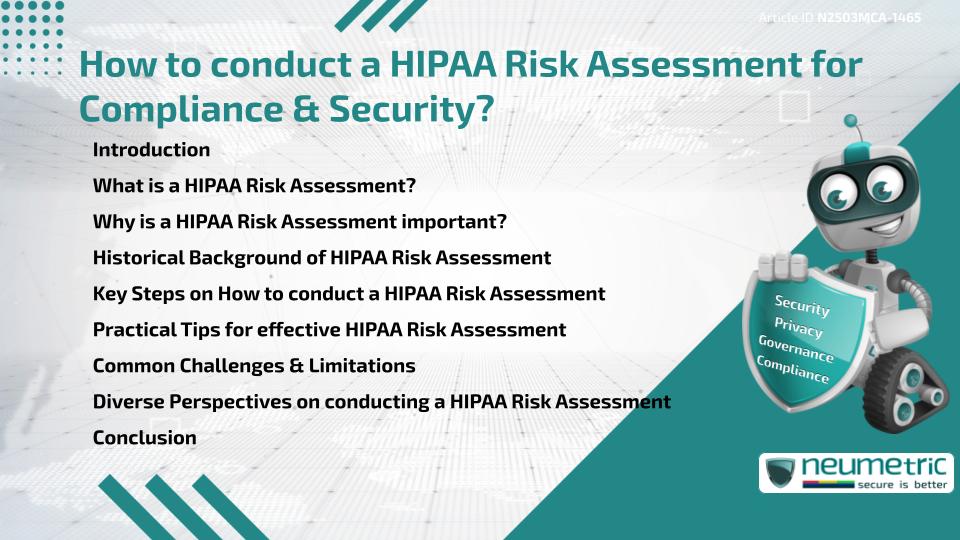Table of Contents
ToggleIntroduction
Ensuring the security of Protected Health Information [PHI] is vital for Healthcare Organisations. Knowing how to conduct a HIPAA Risk Assessment is not just about ticking boxes. It is about protecting Sensitive Data & maintaining Patient Trust. In this article, we will explore what a HIPAA Risk Assessment involves, its historical roots, practical steps, & different viewpoints to help you succeed.
What is a HIPAA Risk Assessment?
A HIPAA Risk Assessment is a detailed review of how an Organisation handles Protected Health Information [PHI]. It looks at Risks & Vulnerabilities that could affect the Security, Integrity or Availability of Data. Understanding how to conduct a HIPAA Risk Assessment means asking questions about where Data is stored, who accesses it & how it is protected.
Why is a HIPAA Risk Assessment important?
Organisations must comply with the Health Insurance Portability & Accountability Act [HIPAA] to avoid Heavy Fines & Reputational Damage. Beyond Legal Compliance, conducting a HIPAA Risk Assessment shows Patients & Partners that an Organisation takes security seriously. It also identifies hidden weaknesses before they lead to costly Breaches.
Historical Background of HIPAA Risk Assessment
HIPAA was signed into Law in 1996 to improve the portability of Health Insurance & set standards for protecting Health Data. In 2003, the Privacy Rule & Security Rule expanded the requirements, including the need for regular Risk Assessments. Knowing how to conduct a HIPAA Risk Assessment properly became essential when Breaches started to rise in the early 2000s, prompting stricter enforcement actions.
Key Steps on How to conduct a HIPAA Risk Assessment
Learning to conduct a HIPAA Risk Assessment involves several clear steps:
- Identify Where PHI is Stored, Received, Maintained or Transmitted: Map out all Systems, Devices & Communication Channels.
- Assess Current Security Measures: Review Firewalls, Access Controls, Encryption & other protections.
- Identify Threats & Vulnerabilities: Think about Natural Disasters, Hackers, System Failures & even Employee Mistakes.
- Determine the Likelihood & Impact of each Risk: Estimate how likely a risk is to occur & how damaging it would be.
- Assign Risk Levels & Prioritise: Focus on the most Critical Risks first for mitigation planning.
- Document Findings & Actions: A written Report helps prove Compliance & sets a clear path for improvement.
- Regularly Update the Assessment: Healthcare threats evolve, so Assessments must stay current.
Understanding how to conduct a HIPAA Risk Assessment properly makes these steps flow naturally, rather than feeling like a checklist exercise.
Practical Tips for effective HIPAA Risk Assessment
To master conducting a HIPAA Risk Assessment, here are some simple but important tips:
- Use Easy-to-Understand Language when communicating findings.
- Engage Multiple Teams including IT, Compliance & Clinical Staff.
- Adopt Templates or Tools that speed up the process without sacrificing depth.
- Perform Internal Audits before Official Assessments to catch errors early.
Common Challenges & Limitations
Even those who know how to conduct a HIPAA Risk Assessment face challenges, some common challenges includes:
- Resource Constraints: Small Organisations may lack time or skilled staff.
- Overlooking Third-Party Risks: Vendors & Partners can introduce Vulnerabilities.
- Complacency After Passing: Compliance is not a one-time achievement. Risks evolve constantly.
Understanding these limitations helps set realistic expectations & builds a culture of Continuous Improvement.
Diverse Perspectives on conducting a HIPAA Risk Assessment
Different organisations approach HIPAA Risk Assessments based on their Size, Resources & Risk Appetite:
- Hospitals tend to have formal, structured assessments every year.
- Small Clinics might conduct lighter, more frequent evaluations.
- Business Associates such as Cloud Storage Providers must also perform Assessments to maintain Compliance.
Recognising these diverse approaches ensures flexibility when learning to conduct a HIPAA Risk Assessment in different environments.
Conclusion
Conducting a HIPAA Risk Assessment is not a luxury but a necessity for Healthcare Organisations. It protects Patient Data, maintains Trust & ensures Regulatory Compliance. Following clear steps, recognising challenges & embracing practical tips make it easier to perform a strong & effective Risk Assessment.
Takeaways
- Knowing how to conduct a HIPAA Risk Assessment is crucial for Data Protection & Compliance.
- Use structured steps like Identifying Risks, Assessing Likelihood & Documenting Actions.
- Practical strategies like Team collaboration & regular Updates lead to stronger results.
- Recognise that Resource constraints & evolving Risks are common challenges.
FAQ
What is the first step to conduct a HIPAA Risk Assessment?
The first step is to identify where Protected Health Information [PHI] is stored, transmitted or received across your organisation.
How frequently should you conduct a HIPAA Risk Assessment?
It is recommended to conduct a HIPAA Risk Assessment at least once a year or whenever there are significant changes in Operations.
Who should be involved to conduct a HIPAA Risk Assessment?
Teams from IT, Compliance, Administration & sometimes Clinical Staff should collaborate during the Assessment Process.
What are common mistakes when learning how to conduct a HIPAA Risk Assessment?
Skipping Third-Party Vendors, underestimating Risks & failing to Document Findings are common errors during Assessments.
Does HIPAA Risk Assessment differ for Small Clinics?
Yes, Small Clinics often take a more streamlined approach but still must meet the core requirements of HIPAA Compliance.
Can you Outsource a HIPAA Risk Assessment?
Yes, many Organisations hire Third-Party Experts to assist or fully manage the HIPAA Risk Assessment process.
What happens if you do not conduct a HIPAA Risk Assessment?
Failing to conduct an Assessment can lead to Data Breaches, loss of Trust & significant Financial Penalties.
Is Training required for conducting a HIPAA Risk Assessment?
While not mandatory, proper training greatly improves the quality & thoroughness of a HIPAA Risk Assessment.
Need help?
Neumetric provides organisations the necessary help to achieve their Cybersecurity, Compliance, Governance, Privacy, Certifications & Pentesting goals.
Organisations & Businesses, specifically those which provide SaaS & AI Solutions, usually need a Cybersecurity Partner for meeting & maintaining the ongoing Security & Privacy needs & requirements of their Clients & Customers.
SOC 2, ISO 27001, NIST, HIPAA, HECVAT, EU GDPR are some of the Frameworks that are served by Fusion – a centralised, automated, AI-enabled SaaS Solution provided by Neumetric.
Reach out to us!


